环境工程专业英语第二版课后习题答案分析解析
环境工程专业英语课后习题部分答案

环境工程专业英语课后习题部分答案(第二版)——钟理主编Exercises 0Write an article about yourself, including personal background, family, education, interests, ambitions and others. Write as much as you would like to.About MyselfMy name is Qin Zheng. I am from Xiangshan, which is a small town in Ningbo District. It is very beautiful and nowadays a lot of films and TV programmes are shot there. More and more people went there for a holiday. The people there are laborious, virtuous and warm hearted. I’m much felicitated that I was born and raised up there. It is my hometown and I will love it forever.My family has been engaged in farming for generations. My relatives are all farmers. My ancestors and my parents have plotted all their life on thin ground. In my family, my father, my mother and I, that’s all.Now I’m in grade three, a third year student in Jiaxing University. Since I have made a lot of friends, I find life in this university both happy and rewarding. I live happily here. I like climbing mountains. I like singing, listening classical music. I like essay, also novel, but my favorite is essay. Unfortunately, although I have read so much, my writing is still not very good.I hope that I can be an useful person for our society. But at the moment, my knowledge is still not rich enough. In order to realize my objectives in life, I will study hard and gain more and more skills and knowledge, such as speaking English and using computer. If I have enough money after graduation from school, I will study driving. It is good to have a good job when someone can drive a car or a bus.Unit 1 (P.4)1 Based on Reading Material, put the following into Chinese.life expectancy :耐用期限,平均寿命poverty-stricken :贫穷的,贫困的,贫乏的smog-laden air :烟雾弥漫的天空,烟雾缭绕的空气,阴霾天气global conditions :全球状况haves and have-nots :富人和穷人underprivileged :社会地位低下的,相对贫困的,生活水平低下的,弱势的savanna :热带大草原,稀树草原predator :食肉动物,捕食者environmental disruptions :环境破坏,环境失调2 Put the following into English.农药—pesticide / agricultural chemicals (including: pesticide, germicide, herbicide)化肥—chemical fertilizer有机废物—organic wastes微生物—microorganism / microbe衰减—attenuation阻滞的—retardant / blocking稀释—dilution添加剂—additive合成塑料—synthetic plastic再生—regenerationUnit 3 (P.19)1 Put the following into Chinese.(1) Raw materials that lose their usefulness because they sit on the shelf too long become waste. 原材料放置过久会失去它们本身性能而变成废弃物。
环境工程专业英语第二版重点课文翻译及复习
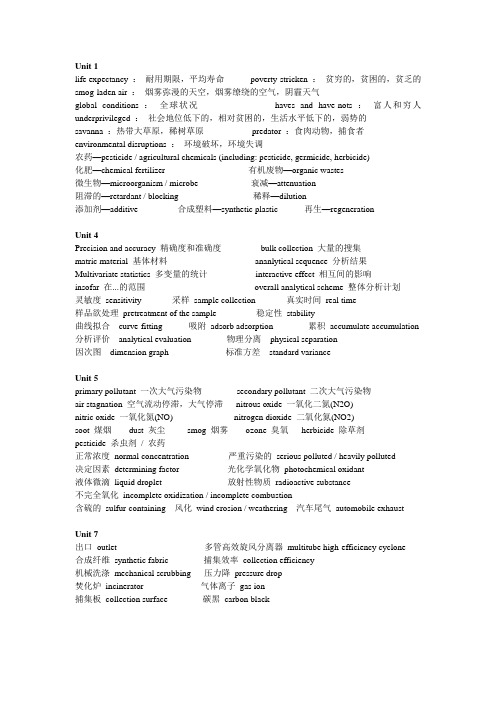
life expectancy :耐用期限,平均寿命poverty-stricken :贫穷的,贫困的,贫乏的smog-laden air :烟雾弥漫的天空,烟雾缭绕的空气,阴霾天气global conditions :全球状况haves and have-nots :富人和穷人underprivileged :社会地位低下的,相对贫困的,生活水平低下的,弱势的savanna :热带大草原,稀树草原predator :食肉动物,捕食者environmental disruptions :环境破坏,环境失调农药—pesticide / agricultural chemicals (including: pesticide, germicide, herbicide)化肥—chemical fertilizer 有机废物—organic wastes微生物—microorganism / microbe 衰减—attenuation阻滞的—retardant / blocking 稀释—dilution添加剂—additive 合成塑料—synthetic plastic 再生—regenerationUnit 4Precision and accuracy 精确度和准确度bulk collection 大量的搜集matric material 基体材料ananlytical sequence 分析结果Multivariate statistics 多变量的统计interactive effect 相互间的影响insofar 在...的范围overall analytical scheme 整体分析计划灵敏度sensitivity 采样sample collection 真实时间real time样品欲处理pretreatment of the sample 稳定性stability曲线拟合curve-fitting 吸附adsorb adsorption 累积accumulate accumulation 分析评价analytical evaluation 物理分离physical separation因次图dimension graph 标准方差standard varianceUnit 5primary pollutant 一次大气污染物secondary pollutant 二次大气污染物air stagnation 空气流动停滞,大气停滞nitrous oxide 一氧化二氮(N2O)nitric oxide 一氧化氮(NO) nitrogen dioxide 二氧化氮(NO2)soot 煤烟dust 灰尘smog 烟雾ozone 臭氧herbicide 除草剂pesticide 杀虫剂/ 农药正常浓度normal concentration 严重污染的serious polluted / heavily polluted决定因素determining factor 光化学氧化物photochemical oxidant液体微滴liquid droplet 放射性物质radioactive substance不完全氧化incomplete oxidization / incomplete combustion含硫的sulfur-containing 风化wind erosion / weathering 汽车尾气automobile exhaustUnit 7出口outlet 多管高效旋风分离器multitube high-efficiency cyclone合成纤维synthetic fabric 捕集效率collection efficiency机械洗涤mechanical scrubbing 压力降pressure drop焚化炉incinerator 气体离子gas ion捕集板collection surface 碳黑carbon black尾气off-gas 可应用性applicability 工业规模full-scale 土壤床soil bed生物过滤器biofilter 固定资本fixed capital 易生物降解的easily biodegraded VOC 挥发性有机化合物APC 大气污染控制Regulatory program 调整项目Financial support 财政支持Operating cost 操作成本Biodegradation capacity 生物降解能力Environmental media 环境介质Biological 生物学的Technologies 技术、工艺Inorganic air pollutants 无机大气污染物Unit 10treatment facilities 处理设备municipality 市政当局, 自治市population equivalent 人口当量basement flooding 地下室浸水per capita per day 每人每天runoff 排水domestic sewage 生活污水type of terrain 地形种类Unit 12land disposal 掩埋处置fecal coliform 粪大肠菌群stringent effluent requirement 严格的废水排放要求assimilation capacity 同化能力practical outlets 可行的排出途径,现实出路aquatic life 水生生物detrimental to human health 对人体健康有害的endogenous phase 内源〔生长〕期Unit 13flow monitoring 流量监测equipment age and reliability 装备老化及其可靠性mechanistic facilities 机械设备microbial activity 微生物活性activated sludge 活性污泥controlling respiration 控制呼吸oxidation ditches 氧化沟on-line automation 在线自动〔监测〕手动控制operator control/ manual control 最优化minimize the effects微处理器microprocessor 统计分析statistical analysis质量衡算mass balance 动力学dynamics氧化还原oxidation and reduction /redox 停留时间residence time模拟simulation 参数parameter 水解hydrolysis 积分integralUnit 1 环境工程本书的内容:本书的目的是使工科和理科学生对环境问题的跨学科的研究有所了解:环境问题的起因,环境问题受关注的原因,如何控制环境问题。
环境工程专业英语考核附答案及评分标准.doc
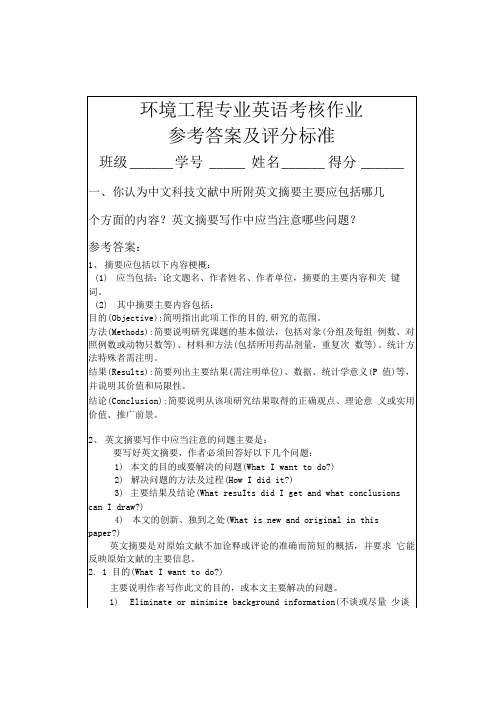
draw?)在写作结果和结论部分时,一般都要尽量结合实验结果或仿真结果的图、表、曲线等来加以说明,使结论部分言之有物,有根有据;同时,对那些看不懂中文的英文读者来说,通过这些图表,结合英文摘要的说明就可以比较清楚地了解论文的结果和结论。
也只有这样,论文的结论才有说服力。
如有可能,在结尾部分还可以将论文的结果和他人最新的研究结果进行比较,以突出论文的主要贡献和创新、独到之处(回答What is new and original in this paper)。
2. 4如何提高英文摘要的文字效能水解酸化一SBR工艺处理果汁废水的研究摘要:采用水解酸化-SBR工艺,对浓缩果汁生产废水处理进行了试验研究,结果表明:当进水COD浓度为3 500-5000 mg/L, pH为6 • 5-7 • 5, 在水解酸化池水力停留时间为8 h, SBR反应池MLSS浓度3500—4 000 mg/L,进水15min,曝气7h,沉淀1 h,出水15min的条件下,出水COD去除率保持在97%以上,SS 去除率达93%以上。
且以水解酸化作为预处理单元可去除果汁废水中的SS达78%以上,为后续SBR工艺的稳定运行创造有利条件,提高组合工艺的整体效果。
关键词:果汁废水水解酸化SBR COD SS参考答案:Study on treatment of syrup wastewater with hydro Iys i s ac i d i f i cat ion-SBR techno IogyAbstract:An exper imentaI study on syrup wastewater treatment with hydro I ys i s ac i d i f i cat i on-SBR techno I ogy was carr i ed out The resu I ts showed that when the COD of i nf I uentwas3 500〜5 OOOmg/L and the pH of i nf I uent was 6. 5〜7. 5, COD and SS remova I rates of the wastewater were over 97% and 93% through the comb i ned techno I ogy, the opt ima I HRT of hydrol ys i s ac i d i f i ca tion was 8h, the opt i ma I MLSS concentration of SBR was about3 500~4 000 mg/L, the times for inflow, aera tion, settlement and outf I ow were 15 m in, 7 h, 1 h and 15 min, respect ive ly. The exper i mentaI so demonstrated that the SS was removed most Iy through the hydrolys is acidification process (more than 78% ), wh ich can create a su itab Ie cond iti on for the subsequent SBR process and enhance the eff i c i ency of the comb i ned technology.Key words:syrup wastewater; hydrolysis acidification; SBR; COD; SS。
环境工程专业英语第一章 unit1 2

waste disposal are often dealt with separately by governmental agencies. 并且从行政管理方面看也是合理的,空气污染、供水、废水处理和固体废物 处置,这些单个环境问题都被政府部门分开单独处理 Unfortunately, many important environmental problems are not ed to an air, water, or land system, but involve interactions between systems. 事实上,许多重大的环境问题并不局限于大气、水或土壤圈中的某个单一系 统,而是各系统之间相互作用。
(简单处理)环境工程专业英语(第二版)

acid rain 酸雨pollution 污染interaction of systems 系统的交互作用environmental problem 环境问题environmental disturbance 环境破坏biotic habitat 生物环境sulfur dioxide 二氧化硫nitrogen oxide 氧化氮carbon dioxide 二氧化碳automobile exhaust 汽车尾气infectious diseases 有传染性的疾病primary air pollutant 一次大气污染物secondary air pollutant 二次大气污染物monoxide 一氧化物dioxide 二氧化物trioxide 三氧化物carbon monoxide 一氧化碳carbon dioxide 二氧化碳sulfur dioxide 二氧化硫sulfur trioxide 三氧化硫nitrous oxide 一氧化二氮nitric oxide 一氧化氮contaminant 污染物strength 强度foreign matter 杂质domestic sewage 生活污水municipal wastewater 城市废水microbe 微生物bacteria 细菌microorganism 微生物total solids 总固体inorganic constituents 无机要素suspended solids (SS)固体悬浮物recontamination 再污染contamination 污染groundwater 地下水surface water 地表水colloid 胶体restriction 限制screening 隔栅coagulation 凝聚flocculation 絮凝sedimentation 沉淀filtration 过滤disinfection 消毒microbial degradation 微生物降解biological degradation 生化降解biofilm process 生物膜法activated sludge process 活性污泥法attached-growth 吸着生长suspended-growth 悬浮生长shock loading 冲击负荷organic loading 有机负荷mixed liquor suspended solids 混合液悬浮固体metabolize 使代谢化metabolism 新陈代谢dissolved oxygen 溶解氧agricultural 农业的solid waste 固体废物municipal 城市化hazardous 危险的industrial 工业的residential 住宅的waterborne diseases 水传染的疾病agrarian society 农业社会industrial society 工业社会industrial revolution产业革命urbanization 城市化industrialization 工业化developed country 发达国家developing country 发展中国家undeveloped country 落后国家nitrogen dioxide 二氧化氮carbon oxides 碳氮化物sulfur oxides 硫氧化物nitrogen oxides 氮氧化物hydrocarbons 碳氢化合物photochemical oxidants 光化学氧化物particulates 颗粒物inorganic compound 无机化合物organic compound 有机化合物radioactive substance 放射性物质heat 热noise 噪声volatile suspended solids (VSS)挥发性悬浮固体颗粒organic matter 有机物质total organic carbon, TOC 总有机碳chemical oxygen demand, COD 化学需氧量biochemical oxygen demand, BOD 生化需氧量biodegradable 可微生物分解的chlorination 氯化消毒ozonation 臭氧消毒softening 软化adsorption 吸附desalination 脱盐处理预加氯prechlorination 预加aeration 曝气activated carbon 活性炭reverse osmosis 反渗透pretreatment process 预处理工艺primary clarifier 初沉池equalization basin 均质池biological treatment process 生物处理工艺aeration basin 曝气池secondary clarifier 二沉池biomass 生物质heterotrophic bacteria 异养菌autotrophic bacteria 自养菌hydraulic retention time (HRT) 水力停留时间sludge residence time (SRT) 污泥停留时间commercial 商业的putrescible 易腐烂的combustible 易燃的flammable 可燃的explosive 易爆的radioactive 放射性的汽车尾气automobile exhaust compaction: 压实,Landfilling 土地填埋incineration: 焚烧composting: 堆肥compaction: 压实,紧凑sanitary landfill 卫生填埋balance 剩下的,余额,结余batch-fed 分批投料refuse 垃圾municipal waste 城市垃圾perform: 执行shut down: 关闭energy recovery 能量回收incomplete combustion 不完全燃烧combustion 燃烧volume reduction 体积缩小anaerobic 厌氧硝化中英互译短语Biological degradation 生化降解equalization basin 调节池aeration basin 曝气池sludge blocs 污泥絮体settling tank 沉淀池dissolved oxygen 溶解氧suspended-growth 悬浮生长pulverized refuse 垃圾破碎biofilm 生物膜well-compacted landfill 压实填埋场nutrient source 营养源mass-burning 大量燃烧fluidized fed incarceration 硫化床燃烧法soil conditioners 土壤改良剂carbon 温室效应greenhouse effect 由CO2 引起的caust by CO2 世界碳预算the world carbon budget 天气自然波动natural fluctuations 全球变暖global warming 厌氧的anaerobic 腐烂Putrefied 甲烷methane 臭氧层ozone layer 气候模型climatic model 正常浓度:normal concentration 严重污染物:heavily polluted 决定因素:determining factor 光化学氧化物:photochemical oxidants 液体微滴:liquid particulates 含硫的:sulfur-containing 放射性物质:radioactiue substance 汽车尾气:automobile exhaust wet oxidation 湿式氧化1、Environment is the physical and biotic habitat which surrounds us; that which we can see, hear, touch, smell, and taste.环境是我们周围的物理和生物环境,我们可以看到、听到、接触到、闻到和品尝到的。
《环境工程专业英语》教学初探

习, 包括科学记数法的读法和加减乘除运算 ; 各种物理量和物理单位的读法 ; 元素周期表 、 化合物的命名 、 化
摘 要: 环境工程专业英语专业词 汇多 , 内容 相对单 一 , 味性差 , 趣 教学 内容很难 吸引学 生 的注意 , 导致
学 生缺乏兴趣和 自 心。从互 动教学 、 信 调整课 程 内容、 核方式 和教学手 段 四个 方面着 手 , 考 对专 业英 语教学
进 行 了初步探索 。 关键词 : 环境工程 ; 专业英语 ; 互动教 学
1 问题分析
与基础英语相 比, 环境工程专业英语具有专业词汇多、 词义专一 、 复合词多、 名词群多等词汇特点, 以及 陈述句多、 复合句多、 被动语态多和虚拟语气多等句式结构特点。 【并且 , 2 专业英语 的内容相对单一 , 趣味性 较基础英语要差得多 , 教学 内容很难吸引学生的注意。这导致学生缺乏兴趣和 自信心, 少数同学连基本的朗 读课文都没有信心完成。因此 , 大部分学生忽视专业英语 的学习, 在专业英语上投入的时间和精力远不及基 础英语 。
基 金项 目: 琼州学院博士科研 启动基金 项 目( Y B 0 18 Q X 2 10 )
第5 期
孙宏元 , 白燕 :环境工程专业英语》 《 教学初探
6 3
2 篇课文进行全文精读讲解。根据我校环境工程专业 学生 的实际情况, 慢讲解 速度 , 放 偏重专业词汇的讲 解, 侧重于文章 的阅读理解和翻译 。同时 , 大多数的专业词汇是基础词汇转化、 派生或合成的 , 因此在讲解词 汇时将构词法讲解清楚 , 帮助学生记忆。 L 2 22 2 前后课程的合理设置 专业课与专业英语的课程前后设置 比较合理 , .. 学生在上课 的时候能与专 业课所学知识较好 的结合 , 能够发挥主观能动性。例如, 在第十三单元 Wa r r tet r es 中, t e m n Po s s 涉及专 eT a c e
环境工程专业英语第二版(化学工业出版社)课文翻译
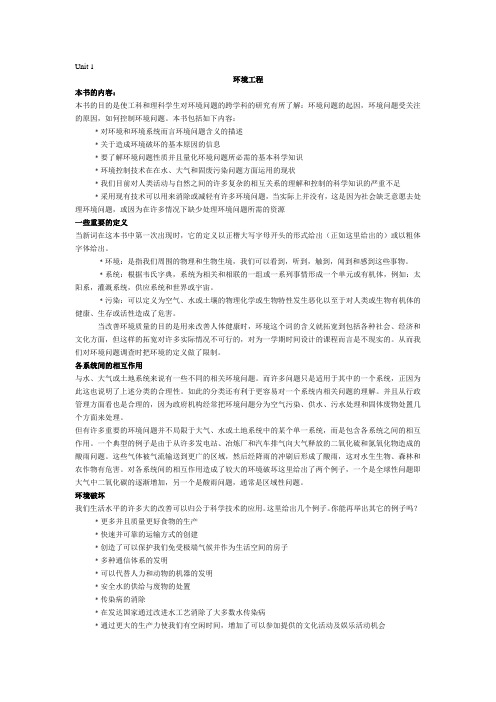
Unit 1环境工程本书的内容:本书的目的是使工科和理科学生对环境问题的跨学科的研究有所了解:环境问题的起因,环境问题受关注的原因,如何控制环境问题。
本书包括如下内容:﹡对环境和环境系统而言环境问题含义的描述﹡关于造成环境破坏的基本原因的信息﹡要了解环境问题性质并且量化环境问题所必需的基本科学知识﹡环境控制技术在在水、大气和固废污染问题方面运用的现状﹡我们目前对人类活动与自然之间的许多复杂的相互关系的理解和控制的科学知识的严重不足﹡采用现有技术可以用来消除或减轻有许多环境问题,当实际上并没有,这是因为社会缺乏意愿去处理环境问题,或因为在许多情况下缺少处理环境问题所需的资源一些重要的定义当新词在这本书中第一次出现时,它的定义以正楷大写字母开头的形式给出(正如这里给出的)或以粗体字体给出。
﹡环境:是指我们周围的物理和生物生境,我们可以看到,听到,触到,闻到和感到这些事物。
﹡系统:根据韦氏字典,系统为相关和相联的一组或一系列事情形成一个单元或有机体,例如:太阳系,灌溉系统,供应系统和世界或宇宙。
﹡污染:可以定义为空气、水或土壤的物理化学或生物特性发生恶化以至于对人类或生物有机体的健康、生存或活性造成了危害。
当改善环境质量的目的是用来改善人体健康时,环境这个词的含义就拓宽到包括各种社会、经济和文化方面,但这样的拓宽对许多实际情况不可行的,对为一学期时间设计的课程而言是不现实的。
从而我们对环境问题调查时把环境的定义做了限制。
各系统间的相互作用与水、大气或土地系统来说有一些不同的相关环境问题。
而许多问题只是适用于其中的一个系统,正因为此这也说明了上述分类的合理性。
如此的分类还有利于更容易对一个系统内相关问题的理解。
并且从行政管理方面看也是合理的,因为政府机构经常把环境问题分为空气污染、供水、污水处理和固体废物处置几个方面来处理。
但有许多重要的环境问题并不局限于大气、水或土地系统中的某个单一系统,而是包含各系统之间的相互作用。
环境工程学课后题答案-完整-第二版-蒋展鹏
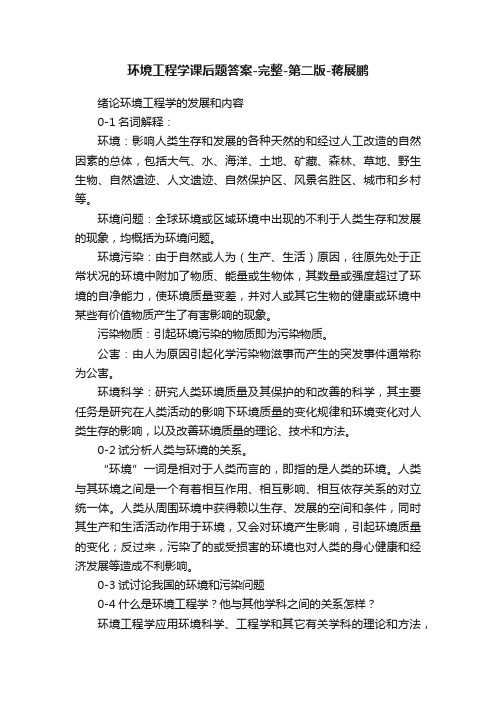
环境工程学课后题答案-完整-第二版-蒋展鹏绪论环境工程学的发展和内容0-1名词解释:环境:影响人类生存和发展的各种天然的和经过人工改造的自然因素的总体,包括大气、水、海洋、土地、矿藏、森林、草地、野生生物、自然遗迹、人文遗迹、自然保护区、风景名胜区、城市和乡村等。
环境问题:全球环境或区域环境中出现的不利于人类生存和发展的现象,均概括为环境问题。
环境污染:由于自然或人为(生产、生活)原因,往原先处于正常状况的环境中附加了物质、能量或生物体,其数量或强度超过了环境的自净能力,使环境质量变差,并对人或其它生物的健康或环境中某些有价值物质产生了有害影响的现象。
污染物质:引起环境污染的物质即为污染物质。
公害:由人为原因引起化学污染物滋事而产生的突发事件通常称为公害。
环境科学:研究人类环境质量及其保护的和改善的科学,其主要任务是研究在人类活动的影响下环境质量的变化规律和环境变化对人类生存的影响,以及改善环境质量的理论、技术和方法。
0-2试分析人类与环境的关系。
“环境”一词是相对于人类而言的,即指的是人类的环境。
人类与其环境之间是一个有着相互作用、相互影响、相互依存关系的对立统一体。
人类从周围环境中获得赖以生存、发展的空间和条件,同时其生产和生活活动作用于环境,又会对环境产生影响,引起环境质量的变化;反过来,污染了的或受损害的环境也对人类的身心健康和经济发展等造成不利影响。
0-3试讨论我国的环境和污染问题0-4什么是环境工程学?他与其他学科之间的关系怎样?环境工程学应用环境科学、工程学和其它有关学科的理论和方法,研究保护和合理利用自然资源,控制和防治环境污染和生态破坏,以改善环境质量,使人们得以健康、舒适地生存与发展的学科。
环境工程学是环境科学的一个分支,又是工程学的一个重要组成部分。
它脱胎于土木工程、卫生工程、化学工程。
机械工程等母系学科,又融入了其他自然科学和社会科学的有关原理和方法。
0-5环境工程学的主要任务是什么?环境工程学应用环境科学、工程学和其它有关学科的理论和方法来研究控制环境污染、保护和改善环境质量,合理利用自然资源的技术途径和技术措施。
环境工程专业英语考试(完整版)

环境与生态:LESSON1:环境与环境工程To the environmental engineer,the wordenvironmentmay take on global dimensions(维面积尺度),may refer to a very localized(局部化地方化)area in which a specific problemmust be addressed(致辞谈到),or may,in the case of contained environments,refer to a small volume of liquid,gaseous(气的),or solid materials within a treatment-plant(处理厂)reactor(反应器).┃The global environmentconsists of the atmosphere(大气圈),the hydrosphere(水圈),the lithosphere(岩石圈)in which the life-sustaining(供养)resources of the earth arecontained.┃The biosphere(生物圈),a thin shell that encapsulates(密封加浓)the earth,is made up of the atmosphere andlithosphereadjacent(接近的临近的)to the surface of the earth,together with the hydrosphere and the life forms of earth.┃Life-sustainingmaterials in gaseous,liquid,and solid forms are cycled though thebiosphere,providing sustenance to all living organisms(生物).Life-sustaining resources(air,food,water)are withdrawn from the biosphere.It is also into the biosphere that waste products in gaseous,liquid and solid forms are discharged(排放).┃Environment engineeringhas been defined as the branch of engineering thatis concerned with(关心)protecting the environment from the potential(潜在的),deleterious(有害的)effects of human activity,protecting human populations from the effect of adverse environmental factors,and improving environmental quality for human health and well-being(幸福福利).┃Humans interactwith their environment(sometimes adversely impacting the environment and sometimes being adversely impacted by pollutants in the environment.An understanding of the nature of the environment and of human interaction with it is a necessaryprerequisite(前提)to understanding the workfortheenvironmental engineering.
环境工程原理第二版课后答案
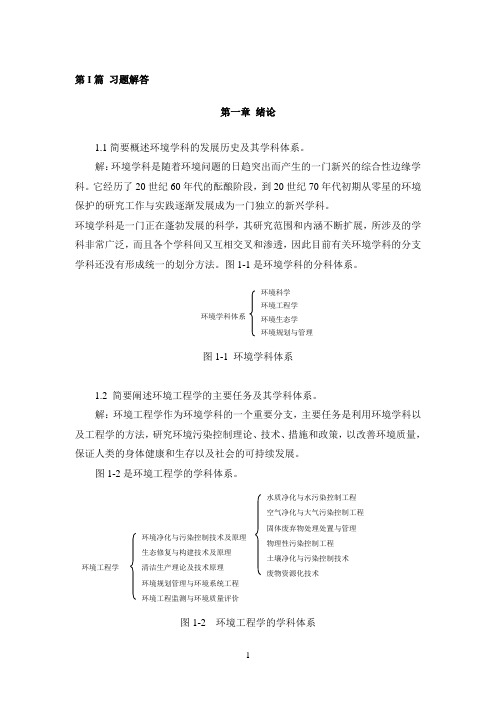
第I 篇 习题解答第一章 绪论1.1简要概述环境学科的发展历史及其学科体系。
解:环境学科是随着环境问题的日趋突出而产生的一门新兴的综合性边缘学科。
它经历了20世纪60年代的酝酿阶段,到20世纪70年代初期从零星的环境保护的研究工作与实践逐渐发展成为一门独立的新兴学科。
环境学科是一门正在蓬勃发展的科学,其研究范围和内涵不断扩展,所涉及的学科非常广泛,而且各个学科间又互相交叉和渗透,因此目前有关环境学科的分支学科还没有形成统一的划分方法。
图1-1是环境学科的分科体系。
图1-1 环境学科体系1.2 简要阐述环境工程学的主要任务及其学科体系。
解:环境工程学作为环境学科的一个重要分支,主要任务是利用环境学科以及工程学的方法,研究环境污染控制理论、技术、措施和政策,以改善环境质量,保证人类的身体健康和生存以及社会的可持续发展。
图1-2是环境工程学的学科体系。
图1-2 环境工程学的学科体系环境工程学 环境净化与污染控制技术及原理生态修复与构建技术及原理清洁生产理论及技术原理环境规划管理与环境系统工程环境工程监测与环境质量评价水质净化与水污染控制工程空气净化与大气污染控制工程固体废弃物处理处置与管理物理性污染控制工程 土壤净化与污染控制技术 废物资源化技术环境学科体系环境科学环境工程学环境生态学环境规划与管理1.3 去除水中的悬浮物,有哪些可能的方法,它们的技术原理是什么?解:去除水中悬浮物的方法主要有:沉淀、离心分离、气浮、过滤(砂滤等)、过滤(筛网过滤)、反渗透、膜分离、蒸发浓缩等。
上述方法对应的技术原理分别为:重力沉降作用、离心沉降作用、浮力作用、物理阻截作用、物理阻截作用、渗透压、物理截留等、水与污染物的蒸发性差异。
1.4 空气中挥发性有机物(VOCs)的去除有哪些可能的技术,它们的技术原理是什么?解:去除空气中挥发性有机物(VOCs)的主要技术有:物理吸收法、化学吸收法、吸附法、催化氧化法、生物法、燃烧法等。
环境工程专业英语第二版课后习题答案分析解析
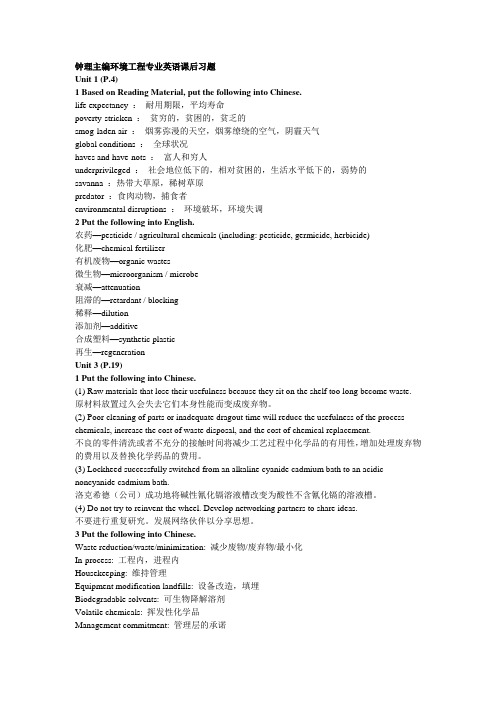
钟理主编环境工程专业英语课后习题Unit 1 (P.4)1 Based on Reading Material, put the following into Chinese.life expectancy :耐用期限,平均寿命poverty-stricken :贫穷的,贫困的,贫乏的smog-laden air :烟雾弥漫的天空,烟雾缭绕的空气,阴霾天气global conditions :全球状况haves and have-nots :富人和穷人underprivileged :社会地位低下的,相对贫困的,生活水平低下的,弱势的savanna :热带大草原,稀树草原predator :食肉动物,捕食者environmental disruptions :环境破坏,环境失调2 Put the following into English.农药—pesticide / agricultural chemicals (including: pesticide, germicide, herbicide)化肥—chemical fertilizer有机废物—organic wastes微生物—microorganism / microbe衰减—attenuation阻滞的—retardant / blocking稀释—dilution添加剂—additive合成塑料—synthetic plastic再生—regenerationUnit 3 (P.19)1 Put the following into Chinese.(1) Raw materials that lose their usefulness because they sit on the shelf too long become waste. 原材料放置过久会失去它们本身性能而变成废弃物。
(2) Poor cleaning of parts or inadequate dragout time will reduce the usefulness of the process chemicals, increase the cost of waste disposal, and the cost of chemical replacement.不良的零件清洗或者不充分的接触时间将减少工艺过程中化学品的有用性,增加处理废弃物的费用以及替换化学药品的费用。
环境工程专业英语
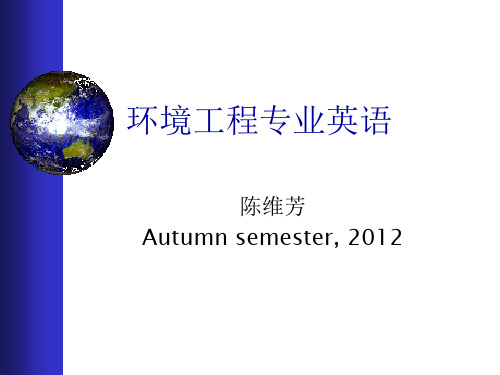
o Acid-base reactions
HA + BOH --> H2O + BA
o Complexation reactions
Transition metal, such as Fe3+, Fe2+, Cu2+, Ag+, Pt2+ etc. + ligands, such as NH3、H2O, CN-, SCN-, F-, Cl-
Environmental systems
• Ecosystem
A freshwater ecosystem in Gran Canaria, an island of the Canary Islands
• Water resources management system
o
Water supply subsystem
• Environmental Engineering
Using
the principles of biology and chemistry, environmental engineers develop solutions to environmental problems
• Environmental Engineers
Environmental problems
• Overpopulation: the presence in a given area of more people than can be supported adequately by the resources available in that area • Pollution: a reduction in the quality of the environment by the introduction of impurities
环境工程专业英语--Unit 2
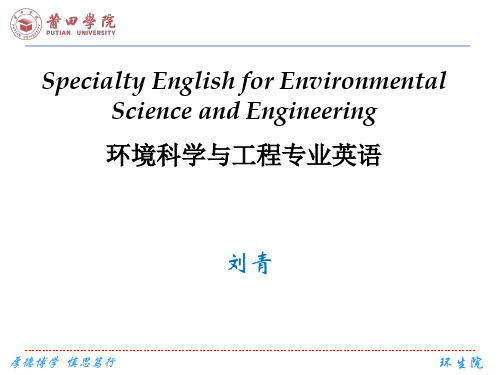
Unit 2 Environmental Engineering
2. System, according to webster’s dictionary, is defined as “a set or arrangement of things so related or connected as to form a unit or organic whole; as, a solar system, irrigation system,supply system, the world or universe”.
1. Environment is the physical and biotic habitat which surrounds us; that which we can see, hear, touch, smell, and taste.
一些重要的定义 在本书中首次出现时,定义以大写字母或是如这里所示, 以粗体显示。 ① 环境是围绕在我们周围的物质和生物栖息地,我们可
Interaction of Systems: • Environmental problems:
➢ One system: water, air, or land
✓ Easier comprehension ✓ Sensible for managerial and administrative reasons
Specialty English for Environmental Science and Engineering
环境科学与工程专业英语
刘青
厚德博学 慎思笃行
环生院
Part 1 Introducineering
环境专业英语课后习题答案

life expectancy :耐用期限poverty-stricken :贫穷的smog-laden air :烟雾弥漫的天空global conditions :全球状况haves and have-nots :富人和穷人underprivileged :社会地位低下的savanna :热带大草原predator :食肉动物,捕食者environmental disruptions :环境破坏Waste reduction/waste/minimization: 减少废物/废弃物/最小化In-process: 工程内,进程内Housekeeping: 维持管理Equipment modification landfills: 设备改造,填埋Biodegradable solvents: 可生物降解溶剂Volatile chemicals: 挥发性化学品Management commitment: 管理层的承诺primary pollutant 一次大气污染物secondary pollutant 二次大气污染物air stagnation 空气流动停滞,大气停滞nitrous oxide 一氧化二氮nitric oxide 一氧化氮(NO)nitrogen dioxide 二氧化氮(NO2)soot煤烟dust 灰尘smog 烟雾ozone 臭氧herbicide 除草剂pesticide 杀虫剂/ 农药VOC 挥发性有机化合物APC 大气污染控制Regulatory program 调整项目Financial support 财政支持Operating cost 操作成本Biodegradation capacity 生物降解能力Environmental media 环境介质Biological 生物学的Technologies 技术、工艺Inorganic air pollutants 无机大气污染物treatment facilities 处理设备per capita per day 每人每天municipality 市政当局, 自治市population equivalent 人口当量basement flooding 地下室浸水runoff 排水domestic sewage 生活污水type of terrain 地形种类unpalatable 味道差的volatile chemicals 挥发性的化学药品scale in hot pipes 热水管积垢harbor pathogens 窝藏病原体precipitate 使沉淀turbid 混浊的intermittent sources 间歇的污染源fixtures 固定设备land disposal 掩埋处置fecal coliform 粪大肠菌群stringent effluent requirement 严格的废水排放要求assimilation capacity 同化能力practical outlets 可行的排出途径,现实出路aquatic life 水生生物detrimental to human health 对人体健康有害的endogenous phase 内源〔生长〕期flow monitoring 流量监测equipment age and reliability 装备老化及其可靠性mechanistic facilities 机械设备microbial activity 微生物活性activated sludge 活性污泥controlling respiration 控制呼吸oxidation ditches 氧化沟on-line automation 在线自动〔监测〕preempted and defaced land 过早地遭受破坏的土地personal conveniences 个人的便利生活条件lavish dependency 过量依赖solar collectors 太阳集热器undue sacrific 过度牺牲social attitudes 社会态度patterns of living 生活方式农药pesticide化肥chemical fertilizer 有机废物organic wastes 微生物microorganism / microbe 衰减attenuation 阻滞的retardant / blocking 稀释dilution 添加剂additive 合成塑料synthetic plastic 再生regeneration正常浓度normal concentration 严重污染的serious polluted / heavily polluted决定因素determining factor光化学氧化物photochemical oxidant液体微滴liquid droplet放射性物质radioactive substance不完全氧化incomplete oxidization / incomplete combustion含硫的sulfur-containing风化wind erosion / weathering汽车尾气automobile exhaust温室效应effect of greenhouse由二氧化碳引起的caused by CO2世界碳预算world carbon budget天气的自然波动natural fluctuations in climate全球变暖global warming厌氧的anaerobic甲烷methane臭氧层ozonosphere 气候模型climatic models腐烂decay出口outlet多管高效旋风分离器multitube high-efficiency cyclone合成纤维synthetic fabric捕集效率collection efficiency机械洗涤mechanical scrubbing压力降pressure drop焚化炉incinerator气体离子gas ion捕集板collection surface碳黑carbon black尾气off-gas可应用性applicability工业规模full-scale土壤床soil bed生物过滤器biofilter固定资本fixed capital易生物降解的easily biodegraded合成有机化合物synthetic organic compound微生物性能microbiological properties普遍接受universal acceptance食品加工food processing精馏rectification蒸发和冷凝evaporation and condensation土壤腐蚀erosion of soil过滤作用percolating/ filtration副产品byproduct脱盐desalination手动控制operator control/ manual control最优化minimize the effects微处理器microprocessor统计分析statistical analysis质量衡算mass balance动力学dynamics氧化还原oxidation and reduction /redox停留时间residence time模拟simulation参数parameter水解hydrolysis积分integral吸声材料sound adsorbing media弹性介质elastic media蒸汽打桩机steam-powered pile driver耳塞ear plug劳动部department of labor环保局Environmental Protection Agency (EPA)环保法environmental protection law(1) Raw materials that lose their usefulness because they sit on the shelf too long become waste.原材料放置过久会失去它们本身性能而变成废弃物。
环境科学与工程专业英语
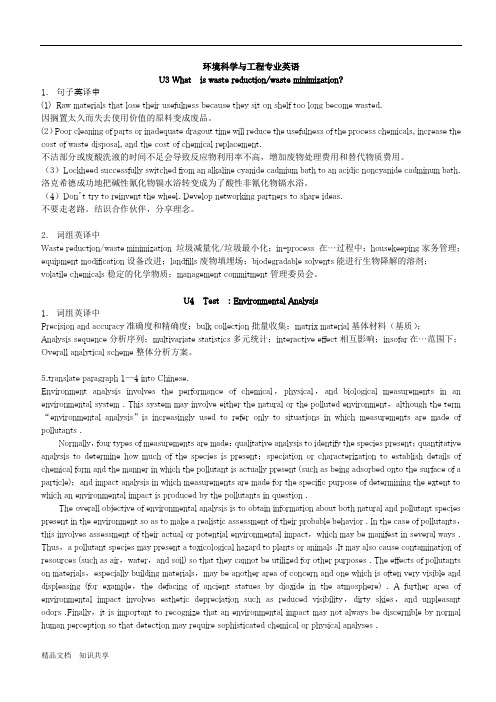
环境科学与工程专业英语U3 What is waste reduction/waste minimization?1.句子英译中(1)Raw materials that lose their usefulness because they sit on shelf too long become wasted.因搁置太久而失去使用价值的原料变成废品。
(2)Poor cleaning of parts or inadequate dragout time will reduce the usefulness of the process chemicals, increase the cost of waste disposal, and the cost of chemical replacement.不洁部分或废酸洗液的时间不足会导致反应物利用率不高,增加废物处理费用和替代物质费用。
(3)Lockheed successfully switched from an alkaline cyanide cadmium bath to an acidic noncyanide cadminum bath.洛克希德成功地把碱性氰化物镉水浴转变成为了酸性非氰化物镉水浴。
(4)Don’t try to reinvent the wheel. Develop networking partners to share ideas.不要走老路。
结识合作伙伴,分享理念。
2.词组英译中Waste reduction/waste minimization 垃圾减量化/垃圾最小化;in-process 在…过程中;housekeeping家务管理;equipment modification设备改进;landfills废物填埋场;biodegradable solvents能进行生物降解的溶剂;volatile chemicals稳定的化学物质;management commitment管理委员会。
环境工程原理第二版课后答案

第I 篇 习题解答第一章 绪论1.1简要概述环境学科的发展历史及其学科体系。
解:环境学科是随着环境问题的日趋突出而产生的一门新兴的综合性边缘学科。
它经历了20世纪60年代的酝酿阶段,到20世纪70年代初期从零星的环境保护的研究工作与实践逐渐发展成为一门独立的新兴学科。
环境学科是一门正在蓬勃发展的科学,其研究范围和内涵不断扩展,所涉及的学科非常广泛,而且各个学科间又互相交叉和渗透,因此目前有关环境学科的分支学科还没有形成统一的划分方法。
图1-1是环境学科的分科体系。
图1-1 环境学科体系1.2 简要阐述环境工程学的主要任务及其学科体系。
解:环境工程学作为环境学科的一个重要分支,主要任务是利用环境学科以及工程学的方法,研究环境污染控制理论、技术、措施和政策,以改善环境质量,保证人类的身体健康和生存以及社会的可持续发展。
图1-2是环境工程学的学科体系。
图1-2 环境工程学的学科体系环境工程学 环境净化与污染控制技术及原理生态修复与构建技术及原理清洁生产理论及技术原理环境规划管理与环境系统工程环境工程监测与环境质量评价水质净化与水污染控制工程空气净化与大气污染控制工程固体废弃物处理处置与管理物理性污染控制工程 土壤净化与污染控制技术 废物资源化技术环境学科体系环境科学环境工程学环境生态学环境规划与管理1.3 去除水中的悬浮物,有哪些可能的方法,它们的技术原理是什么?解:去除水中悬浮物的方法主要有:沉淀、离心分离、气浮、过滤(砂滤等)、过滤(筛网过滤)、反渗透、膜分离、蒸发浓缩等。
上述方法对应的技术原理分别为:重力沉降作用、离心沉降作用、浮力作用、物理阻截作用、物理阻截作用、渗透压、物理截留等、水与污染物的蒸发性差异。
1.4 空气中挥发性有机物(VOCs)的去除有哪些可能的技术,它们的技术原理是什么?解:去除空气中挥发性有机物(VOCs)的主要技术有:物理吸收法、化学吸收法、吸附法、催化氧化法、生物法、燃烧法等。
环境工程专业英语unit12-14

12单元污水处理从社区或市区收集的污水必须最终转化成可以接受的水,或者排放入水体,或者再利用。
设计师和公共健康部门面临的复杂问题是:为了确保公众健康和保护环境,在特定的场合必须达到哪一级的处理才能允许排放。
要解答这个问题首先需要详细的分析当地的实际情况和需求,其次需要应用科学知识和基于经验的工程决断,最后需要考虑联邦、州和当地法规。
在有些情况下,还需要作详细的风险评估。
处理方法以物理法为主的水处理方法称为单元操作。
以化学和生物反应为主去除污染物的方法成为单元反应。
目前,单元操作和单元反应共同应用于水处理,分成了不同的级别,众所周知,有预处理、一级处理、高级的一级处理,二级处理(包括或者不包括营养物质的去除),三级或者称为深度处理。
(见表12.1)在预处理中,能够损坏设备的大的固体被去除,例如大物体、碎布、砂粒。
在一级处理中物理操作,通常是沉淀,被用来去除污水中的漂浮物和沉淀物质。
高级的一级处理是指在一级处理过程中加入化学试剂,以提高悬浮固体和溶解固体的去除率。
在二级处理中,利用生物和化学过程去除大部分有机物。
在深度处理中,额外的单元操作和单元过程结合在一起被用来去除剩余的悬浮固体和在二级处理中不能被有效去除的其他成分。
(enhance the removal to a lesser extent)大概20年前,生物营养素的去除,也就是氮磷的去除,曾被认为是深度水处理中的革新工艺。
事实上,由于对BNR机理的大量研究,和它应用的优势,以及BNR系统的大量应用,营养素的去除已经成为了常规水处理的一部分。
与化学法相比,BNR用的化学试剂少,减少了固体废弃物的产生量,降低了能耗。
由于BNR法在水处理中的重要性,BNR被并入到生物处理方法的理论、应用、设计研究中。
(for all practical purposes:事实上)通常称为天然系统的土地处理工艺,,融合了物理、化学和生物处理机理,出水水质与深度处理相似或更好。
环境工程专业英语 第二版 华南理工大学 钟理 主编

环境工程专业英语第二版华南理工大学钟理主编纯手打,自己检查哈!Unit 33Reading Material:Pollution Control Strategies[Ⅱ]Legal Aspects and the Role of GovernmentLegislation to control the quality of water and air and the disposal of solid and hazardous wastes was introduced,with particular emphasis on the United States and Canada. It is the responsibility of government,at the national,state,provincial,or local level,to enact and update environmental control legislation. This legislation is generally written to provide the broad goals and objectives for environmental quality. It does not provide the means and methods by which these goals are to be achieved. Nor need it provide the details which are necessary to monitor and control the performance of pollution control facilities. It is,therefore,necessary for governments at all levels to establish regulatory strategies,in order to implement the broadly stated objectives of general legislation.The goal of environmental management strategies is to maintain or improve the quality of the ambient or surrounding environment. Ambient standards art determined for a number of different characteristics or pollutants within a medium suchas air or water. These standards are designed tominimize risks to the health of humans,animals,or theenvironment in general. The components for which these ambient standards are set must be quantifiable and scientifically measurable. In water and air,criteria are set for allowable concentrations of a variety of pollutants. Furthermore,the pollutants for which ambient standards are must be related to their sources. A regulatory agency can set ambient standards and monitor ambient conditions,but it cannot control or manage conditions except by controlling the sources of the pollutants which affect the ambient conditions. For example,in the air,it is desirable to maintain the concentration of particulates below a certain level. To do this,we must determine the possible sources of the particulates. Some of these sources may be identifiable,such as a smokestack or a burning garbage dump. But much of the particulate matte may come from unidentifiable or nonpoint sources,such as open fields, highways,or a forest fire many miles away. After the sources have been identified,it is necessary to relate the rate at which the pollutants are being released from the sources to the ambient concentrations. when this is done,it is possible to set allowable limits on the discharge of pollutants at the sources. This forms the basis for effluent standards.Effluent standards are ambient standards because they can be monitored and controlled in many cases. Even though the ambient quality is what we are interested in preserving,we normally try to achieve this by controlling effluent quality and quantity.Three main instruments are available to government for environmental control:direct regulation ,polluter subsidies,and they all work to internalize pollution costs to the polluter. They can be applied independently,but are usally applied in combination,Each of these instruments appears in a variety of forms,We shall consider some of the more common forms in which they are applied,as well as other interesting possibilities for controlling pollution,Direct regulation. The government can use its legislative powers to regulate the actions of individuals,corporations,and lower levels of government,Therefore,through direct legislative action,thequantity,quality,and location of discharges of pollutants can be regulated. The main forms of direct regulation are zoning;prohibition,or zero discharge;and effluent standards.Zoning. Zoning regulations are one of the simplest and oldest forms of pollution control and are still a part of almost every pollution control strategy. The objective is to separate the polluter form the rest of society by either space or time. Aresult of the so-called sanitary awakening in mid-nineteenth century Britain was the realization that open garbage dumps had to be removed from areas of dense population and kept away from public water supplies. Local bylaws were enacted to ensure that this was done so that the benefits to public health were realized. The prohibition on the burning of coal in nineteenth-century London whileparliament was in session is another example of this type of zoning. More recent examples of zoning to separate pollutions from the public are the location of airports, the use of curfews on airport operations,and the construction of tall chimneys or long marine sewage outfalls.Prohibition or Zero Discharge. Another form of direct regulation of pollution is prohibition,also known as zero discharge. The advantages of such a concept are obvious. First and foremost there would be no change in environmental quality. Moreover,all resources would have to be completely converted into useful products or stored indefiniteky. And the legislation would appear to be equitable,since the same regulation would apply to everyone. Such a concept,however,is normally impossible to realize,A simple materials balance shows that any resource taken from the environment,including energy,must be returned in some form. Even if it were conceivable to recycle all wastes into new products,there would still be a large energy requirement to achieve this. For most activities,zero discharge would be expensive if not impossible to achieve,At present,producers of extremely hazardous wastes,for which no treatment is available,are the only ones subjected to zero discharge requirements. They must store their wastes until a means of safe disposal is found.Effluent Standards. Effluent discharge standards are the most common and the most useful form of direct regulation. They can be in the form of across-the-board standards which require that effluents of allpolluters meet the same criteria,or thay may be individually developed for each polluter. The advantages of an across-the-board type of approach are that it is easy to administer,it appears fair to all polluters,and it provides the most rigid control over environmental quality. The disadvantages are that it may be uneconomical,and therefore impractical,to insist that all polluters meet the same effluent standards. Some polluters may easily meet standards that others will be unable to meet at all,or only at a very high cost. The different assimilative capacities of the environment in different locations can be taken into account only on a case-by-case basis. For example,a large,fast-moving river can accept a much larger amount of organic pollution than a small creek,and therefore pollutant concentrations from point-source discharges coule be much higher before river quality is seriously affected. Nevertheless,most jurisdictions prefer to set common effluent discharge guidelines,which must be met unless the contributor is specifically exempted.Subsidies. One method of encouraging polluters to comply with regulations is to provide money to help cover their costs. These subsidies may be in the form of direct payments or grants based on a percentage of the cost of pollution abatement or on a percentage reduction in effluent quantity or strength. They may also take the form of low-interest loans for the capital costs of improved treatment facilities.Alternatively,governments can reduce or defer taxes or relax other government requirements to encourage spending on pollution control.The main advantage of subsidies is that they reduce the costs of pollution abatement to the polluter and limit the associated increase in production costs. Governments grants can be used to cover capital costs,and tax incentives can be used to relieve operation and maintenance costs. Subsidies (the carrot) combined with regulations (the stick ) can be used by government to reduce stress on the environment and at the same time encourage research and development by industry in pollution abatement technology . The main disadvantage of polluter subsidies is that the government will have to increase taxes or direct money form other programs in order to pay the subsidies. This is partially offset by decreased expenditures needed to correct the effects of damage due to pollution(i.e. , expenditures on water treatment plants or public health care). However,these returns may be small compared to the costs involved. A general tax increase may seem fair when everyone benefits from an increase in environmental quality. In fact,however,people benefit to varying degrees,and some may balk at paying money for what appears to be someone else’s problem.Another serious drawback to the subsidy system is that it can be easily abused. The idea of paying someone to stop damaging the environment sounds suspiciously like a criminal protection racket . Allpotential polluters will want to be paid for not polluting. Companies may find that the subsidy available for waster reduction exceeds their actual costs of making the change. They may then increase their production above normal simply to receive a subsidy and go on to dump the extra goods at a lower price. In this situation,a polluting industry has been rewarded while its competitors who already treat their wastes adequately get no benefit.Service charges. Service or user charges are similar to subsidies in that monetary means are used to encourage a polluter to comply with effluent requirements. Charges are the most direct may of internalizing the costs of pollution to polluter. There are numerous types of service charges,but in general,money is paid to the local government or agency in proportion to the amount of pollution. The government or agency may then use the money to pay for and operate central pollution control facilities.The obvious advantage of a service charge is that it is the polluter who pays for the costs of polluting. The system rewards those industries that are clean and efficiently run and penalizes those that are dirty and wasteful. Also,it does not encourage increases in polluting activity ,as a subsidy system might. Finally,the administration of such a system is relatively easy ,requiring only the monitoring of discharges.The disadvantages are that production and operating costs for the industries connected may rise. If the service charges arenominal,industries may find it less expensive to simply continue polluting,If the charges are high enough force an industry to stop or severely restrict its effluent discharges,the industry may close down. In any event,the charges will be passed on in the form of increased prices for the industry’s products. Since each industry has different capabilities and costs related to controlling its wastes,a uniform service charge could upset the economic balance between competing industries. However,to customize effluent charges for each polluter would be an administrative burden and appear to be unfair.We are all familiar with charges for municipal services. In urban areas,we pay through property taxes or special levies to have refuse and sewage removed from our homes. In the same way ,industries may find it more convenient to pay to have their untreated wastes removed and disposed of at a central treatment facility. In some of the heavily industrialized areas of Europe, this has been found to be an attractive and efficient way to dispose of industrial wastes. In many cases,the extra cost of waste collection is offset by the economy of scale of large ,specialized treatment plants.In general,all wastes which do not harm the system or affect the operation of the treatment plant shoule be accepted without pretreatment.If the wastes are stronger than “normal” sewage,then a charge,or more correctly,a surcharge,should be assessed against the industry for the extra cost of sewage treatment . For this approach,a surcharge formula setting out the charges for accepting wastes stronger than normal would have to be included in the industrial waste bylaw. Ideally,charges for sewage treatment should be related to the cost of providing the facilities and the benefits received. The practical application of this method isdifficult,however,and various methods of charging for industrial wastes have evolved.。
- 1、下载文档前请自行甄别文档内容的完整性,平台不提供额外的编辑、内容补充、找答案等附加服务。
- 2、"仅部分预览"的文档,不可在线预览部分如存在完整性等问题,可反馈申请退款(可完整预览的文档不适用该条件!)。
- 3、如文档侵犯您的权益,请联系客服反馈,我们会尽快为您处理(人工客服工作时间:9:00-18:30)。
钟理主编环境工程专业英语课后习题Unit 1 (P.4)1 Based on Reading Material, put the following into Chinese.life expectancy :耐用期限,平均寿命poverty-stricken :贫穷的,贫困的,贫乏的smog-laden air :烟雾弥漫的天空,烟雾缭绕的空气,阴霾天气global conditions :全球状况haves and have-nots :富人和穷人underprivileged :社会地位低下的,相对贫困的,生活水平低下的,弱势的savanna :热带大草原,稀树草原predator :食肉动物,捕食者environmental disruptions :环境破坏,环境失调2 Put the following into English.农药—pesticide / agricultural chemicals (including: pesticide, germicide, herbicide)化肥—chemical fertilizer有机废物—organic wastes微生物—microorganism / microbe衰减—attenuation阻滞的—retardant / blocking稀释—dilution添加剂—additive合成塑料—synthetic plastic再生—regenerationUnit 3 (P.19)1 Put the following into Chinese.(1) Raw materials that lose their usefulness because they sit on the shelf too long become waste. 原材料放置过久会失去它们本身性能而变成废弃物。
(2) Poor cleaning of parts or inadequate dragout time will reduce the usefulness of the process chemicals, increase the cost of waste disposal, and the cost of chemical replacement.不良的零件清洗或者不充分的接触时间将减少工艺过程中化学品的有用性,增加处理废弃物的费用以及替换化学药品的费用。
(3) Lockheed successfully switched from an alkaline cyanide cadmium bath to an acidic noncyanide cadmium bath.洛克希德(公司)成功地将碱性氰化镉溶液槽改变为酸性不含氰化镉的溶液槽。
(4) Do not try to reinvent the wheel. Develop networking partners to share ideas.不要进行重复研究。
发展网络伙伴以分享思想。
3 Put the following into Chinese.Waste reduction/waste/minimization: 减少废物/废弃物/最小化In-process: 工程内,进程内Housekeeping: 维持管理Equipment modification landfills: 设备改造,填埋Biodegradable solvents: 可生物降解溶剂Volatile chemicals: 挥发性化学品Management commitment: 管理层的承诺Unit41.Put the following into Chinese.Precision and accuracy 精密度和准确度bulk collection 散装收集matrix material 基质analytical sequence 分析序列multivariate statistics 多元统计interactive effect 互动效应insofar adv. 在…的范围;在…情况下overall analytical scheme 整体分析方案2.Put the following into English.灵敏度sensitivity采样sampling真实时间actual time样品预处理sample pretreatment稳定性stability曲线拟和Curve fit吸附adsorption累积accumulate分析评价analysis evaluation物理分离physical Separation因次图Dimensional diagram标准方差Standard varianceUnit 5 (P.34)1 Put the following words or phrase into Chinese.primary pollutant 一次大气污染物secondary pollutant 二次大气污染物air stagnation 空气流动停滞,大气停滞nitrous oxide 一氧化二氮(N2O)nitric oxide 一氧化氮(NO)nitrogen dioxide 二氧化氮(NO2)soot 煤烟dust 灰尘smog 烟雾ozone 臭氧herbicide 除草剂pesticide 杀虫剂/ 农药2 Put the following into English.正常浓度normal concentration严重污染的serious polluted / heavily polluted决定因素determining factor光化学氧化物photochemical oxidant液体微滴liquid droplet放射性物质radioactive substance不完全氧化incomplete oxidization / incomplete combustion含硫的sulfur-containing风化wind erosion / weathering汽车尾气automobile exhaustUnit 6 (P.40)1 Put the following into Chinese(1) The most severe sequence of CO2 induced global warning would be melting of the polarice-caps and the subsequent rise of ocean levels and inundation of coastal plains.由CO2 所引起的全球变暖的最严重后果是极地冰帽的熔化,以及随之而来的海平面上升所引发的沿海平原的洪水。
(2) Although global warming from the already elevated levels of atmospheric CO2 has been predicted by most climatic models, such a warming has not been empirically observed.虽然大多数气候模型已经预测大气中CO2 浓度的增加将引起全球变暖,但对于这样的气候变暖还没有实证观察过。
(3) Although they indicate trends in average surface temperatures and climate, they unfortunately coincide with increased industrialization and pollution.尽管这些资料表明了平均地面温度和气候的趋势,但不幸的是,恰恰遇上了这段时期内日益增强的工业化和污染。
2 Put the following into English.温室效应effect of greenhouse由二氧化碳引起的caused by CO2世界碳预算world carbon budget天气的自然波动natural fluctuations in climate全球变暖global warming厌氧的anaerobic甲烷methane臭氧层ozonosphere气候模型climatic models腐烂decayUnit 7 (P.47)3 Put the following into English.出口outlet多管高效旋风分离器multitube high-efficiency cyclone合成纤维synthetic fabric捕集效率collection efficiency机械洗涤mechanical scrubbing压力降pressure drop焚化炉incinerator气体离子gas ion捕集板collection surface碳黑carbon blackUnit 8 (P.52)1 Put the following into English.尾气off-gas可应用性applicability工业规模full-scale土壤床soil bed生物过滤器biofilter固定资本fixed capital易生物降解的easily biodegraded2 Put the following into Chinese.VOC 挥发性有机化合物APC 大气污染控制Regulatory program 调整项目Financial support 财政支持Operating cost 操作成本Biodegradation capacity 生物降解能力Environmental media 环境介质Biological 生物学的Technologies 技术、工艺Inorganic air pollutants 无机大气污染物Unit 10 (P.66)1 Put the following into Chinese.treatment facilities 处理设备per capita per day 每人每天municipality 市政当局, 自治市population equivalent 人口当量basement flooding 地下室浸水runoff 排水domestic sewage 生活污水type of terrain 地形种类Unit 11 (P.73)1 According to Reading Material, put the following into Chinese. unpalatable 味道差的volatile chemicals 挥发性的化学药品scale in hot pipes 热水管积垢harbor pathogens 窝藏病原体precipitate 使沉淀turbid 混浊的intermittent sources 间歇的污染源fixtures 固定设备2 According to Reading Material, put the following into English. 合成有机化合物synthetic organic compound微生物性能microbiological properties普遍接受universal acceptance食品加工food processing精馏rectification蒸发和冷凝evaporation and condensation土壤腐蚀erosion of soil过滤作用percolating/ filtration副产品byproduct脱盐desalinationUnit 12 (P.81)1 According to Reading Material, put the following into Chinese. land disposal 掩埋处置fecal coliform 粪大肠菌群stringent effluent requirement 严格的废水排放要求assimilation capacity 同化能力practical outlets 可行的排出途径,现实出路aquatic life 水生生物detrimental to human health 对人体健康有害的endogenous phase 内源〔生长〕期Unit 13 (P.89)1 Based on Reading Material, put the following into Chinese. flow monitoring 流量监测equipment age and reliability 装备老化及其可靠性mechanistic facilities 机械设备microbial activity 微生物活性activated sludge 活性污泥controlling respiration 控制呼吸oxidation ditches 氧化沟on-line automation 在线自动〔监测〕2 Based on Reading Material, put the following into English.手动控制operator control/ manual control最优化minimize the effects微处理器microprocessor统计分析statistical analysis质量衡算mass balance动力学dynamics氧化还原oxidation and reduction /redox停留时间residence time模拟simulation参数parameter水解hydrolysis积分integralUnit141.Put the following into Chinese.biological degradation 生物降解;equalization basin 稳定糖; 均化池; 调节池; 均质池aeration basin 曝气池;曝气塘;通气池sludge flocs 污泥絮体setting tank 固体沉降槽;硬化槽dissolved oxygen 溶解氧biofilm 生物膜;菌膜n.suspended-growth 悬浮生长Unit181.Put the following sentences into English.(1)饮食废物的重要特点在于它具有易腐烂性,尤其在温暖天气里,会极快地腐烂。
